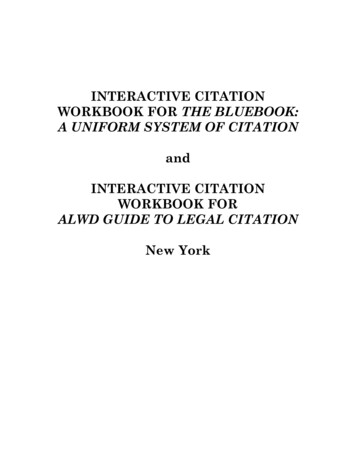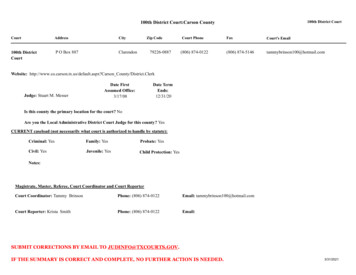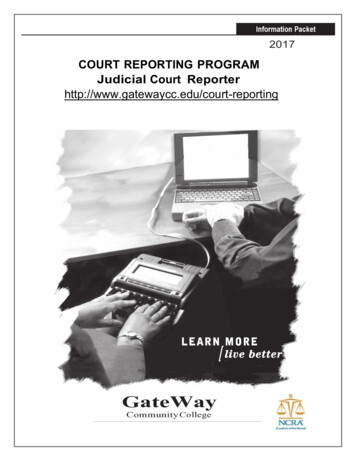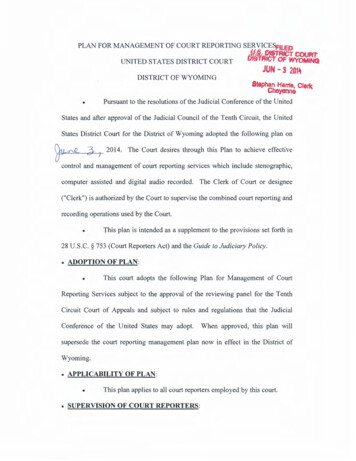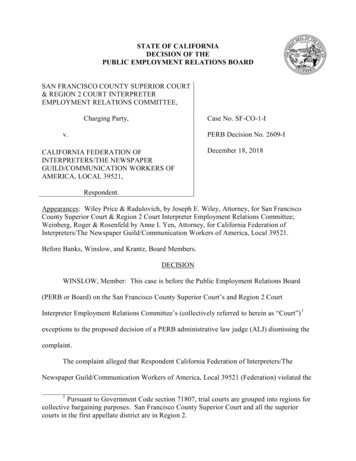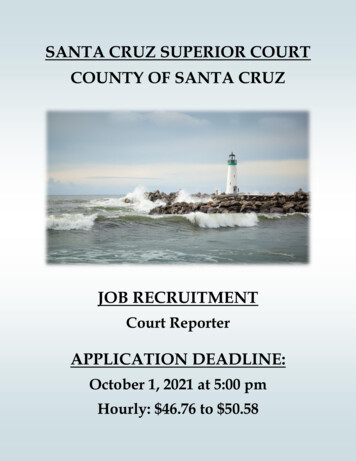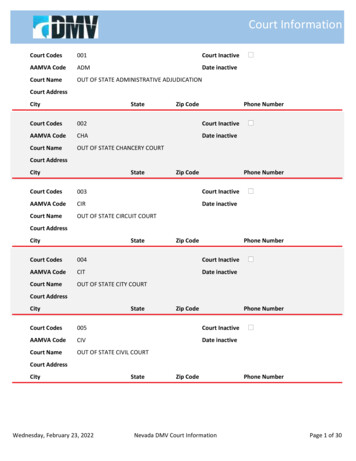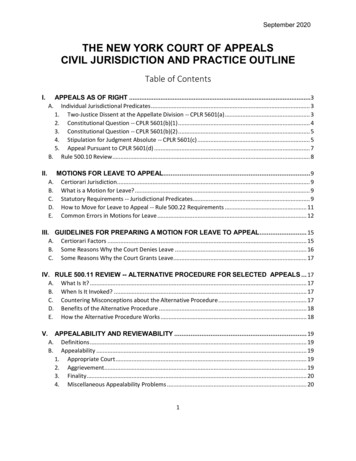
Transcription
September 2020THE NEW YORK COURT OF APPEALSCIVIL JURISDICTION AND PRACTICE OUTLINETable of ContentsI.APPEALS AS OF RIGHT .3A. Individual Jurisdictional Predicates . 31. Two-Justice Dissent at the Appellate Division -- CPLR 5601(a) . 32. Constitutional Question -- CPLR 5601(b)(1) . 43. Constitutional Question -- CPLR 5601(b)(2) . 54. Stipulation for Judgment Absolute -- CPLR 5601(c) . 55. Appeal Pursuant to CPLR 5601(d) . 7B. Rule 500.10 Review . 8II.MOTIONS FOR LEAVE TO APPEAL. 9Certiorari Jurisdiction . 9What is a Motion for Leave? . 9Statutory Requirements -- Jurisdictional Predicates. 9How to Move for Leave to Appeal -- Rule 500.22 Requirements . 11Common Errors in Motions for Leave . 12A.B.C.D.E.III. GUIDELINES FOR PREPARING A MOTION FOR LEAVE TO APPEAL. 15A. Certiorari Factors . 15B. Some Reasons Why the Court Denies Leave . 16C. Some Reasons Why the Court Grants Leave. 17IV. RULE 500.11 REVIEW -- ALTERNATIVE PROCEDURE FOR SELECTED APPEALS . 17A. What Is It? . 17B. When Is It Invoked? . 17C. Countering Misconceptions about the Alternative Procedure . 17D. Benefits of the Alternative Procedure . 18E. How the Alternative Procedure Works . 18V.A.B.APPEALABILITY AND REVIEWABILITY . 19Definitions . 19Appealability . 191. Appropriate Court . 192. Aggrievement . 193. Finality . 204. Miscellaneous Appealability Problems . 201
C.Reviewability . 221. Preservation -- Issues Reviewable. 222. CPLR 5501(a) -- Review of Prior Nonfinal Orders and Determinations . 243. Scope of Review . 25VI. WHAT IS A FINAL DETERMINATION? -- A SYSTEMATIC APPROACH. 28A. Constitutional Requirement. 28B. Nonfinality. 281. Merits Not Addressed -- Too Early . 282. Merits Not Addressed -- Too Late . 293. Merits Addressed -- Remittals for Further Judicial Action . 314. Merits Addressed -- Claims Pending . 33C. Exceptions to Nonfinality . 341. Express Severance . 342. Implied Severance . 353. Party Finality . 354. Irreparable Injury . 36D. Separate Special Proceedings . 37VII. THE “NECESSARILY AFFECTS” REQUIREMENT . 38A. General Overview . 38B. The "Necessarily Affects" Requirement . 39C. Examples of Orders That Necessarily Affect Final Judgments . 39D. Examples of Nonfinal Orders That Do Not Necessarily Affect Final Judgments . 40FINALITY CONTINUUM . 412
THE NEW YORK COURT OF APPEALSCIVIL JURISDICTION AND PRACTICE OUTLINEPrepared by the Clerk's Office, New York Court of AppealsI.A.APPEALS AS OF RIGHTIndividual Jurisdictional PredicatesAn appeal as of right must meet one of the following statutory jurisdictionalpredicates (CPLR 5601) or it is subject to dismissal upon motion or by the Courtsua sponte (see 22 NYCRR 500.10).1.Two-Justice Dissent at the Appellate Division -- CPLR 5601(a)a.The dissent must be on a question of law (compare Scheer vKoubek, mot to dismiss appeal denied 69 NY2d 983 [1987][difference between majority and dissent centered on conflictinginterpretations of Insurance Law and consequent conclusion as towhether plaintiff made out a prima facie case: legal question] andMatter of Gardstein v Kemp & Beatley, Inc., mot to dismiss appealdenied 61 NY2d 900 [1984] [dispute between majority and dissentfocuses on sufficiency (not weight) of the evidence to supportfinding of corporate oppression of shareholder: legal question] withMerrill v Albany Med. Center Hosp., appeal dismissed 71 NY2d 990[1988] [dissent predicated on unpreserved issues] and Matter ofCindy M.G. v Michael A., appeal dismissed 71 NY2d 948 [1988][difference between majority and dissent based on differing view ofunderlying facts, not applicable legal standard]; see generallyArthur Karger, Powers of the New York Court of Appeals § 6:15, at203-207 [3d ed rev 2005]).b.The dissent must be in appellant's favor (Matter of Barron & Vesel vGammerman, cross appeal dismissed 63 NY2d 671 [1984];Christovao v Unisul-Uniao de Coop. Transf., 41 NY2d 338 [1977]).c.The Appellate Division order must be final.3
2.Constitutional Question -- CPLR 5601(b)(1) -- Appeal from Final AppellateDivision OrderThe constitutional question must be both directly involved in the AppellateDivision order and substantial. The appellant has the burden ofestablishing the direct involvement of the constitutional question (seeKarger, § 39, at 245).a.Direct Involvement (see Karger, § 7:8; 7:9-7:10,at 231-243).i.The constitutional question must have been properly raisedin the courts below. Thus, the issue must be preservedbefore the court of original instance (Matter of Schulz v Stateof New York, 81 NY2d 336, 344 [1983]; Matter of ShannonB., appeal dismissed 70 NY2d 458, 462 [1987]), and raisedagain at, or at least be passed upon by, the AppellateDivision on an appeal to that court, if one was taken (seeMatter of Skenesborough Stone, Inc. v Village of Whitehall,appeal dismissed 95 NY2d 902 [2000]).ii.b.The Appellate Division must have taken a view of the casethat necessarily required it to pass upon the constitutionalissue raised. Thus, an appeal will be dismissed where theAppellate Division's decision rests on an independentnonconstitutional ground (Marwanqa v Human ResourcesAdmin., mot to dismiss appeal granted 69 NY2d 1037 [1987][Statute of Limitations]; Matter of Fossella v Dinkins, appealdismissed 66 NY2d 162,168 [1985] [statutory grounds];Matter of Cioffi v Town of Guilderland, appeal dismissed 69NY2d 984 [1987] [mootness]; Burns v Egan, appealdismissed 68 NY2d 806 [1986] [res judicata, laches,standing]).Substantiality (see Karger, §7:5, at 226-228)Whether a substantial constitutional question is presented is adetermination that must be made on a case by case basis. TheCourt has examined the nature of the constitutional interest atstake, the novelty of the constitutional claim, whether the argumentraised may have merit, and whether a basis has been establishedfor distinguishing a state constitutional claim (if asserted) from afederal constitutional claim. The Court has stated that questionsthat have been "clearly resolved against an appellant's position . . .lack the degree of substantiality necessary to sustain an appeal asof right under CPLR 5601(b)(1)" (Matter of David A.C., 43 NY2d708, 709 [1977]). On the other hand, a constitutional argument4
need not prevail on the merits to support an appeal onconstitutional grounds (see Rose v Moody, 83 NY2d 65, 69 [1993]).3.4.Constitutional Question -- CPLR 5601(b)(2) -- Direct Appeal from Court ofOriginal Instance (When That Court Is Not the Appellate Division)a.The only question involved must be the constitutionality of astatutory provision; where issues are involved that must beresolved in addition to the constitutional question, the appeal istransferred to the Appellate Division (Jetro Cash and Carry Enters.v State of New York Dept. of Taxation and Fin., appeal transferred81 NY2d 776 [1992] [discussion of plaintiff's possible failure toexhaust administrative remedies]; Town of Brookhaven v State ofNew York, appeal transferred 70 NY2d 999 [1998] [Court requiredto determine whether disputed material issues of fact existed priorto determining whether summary judgment could be granted onconstitutional claims; threshold finality inquiry]; Matter of Morley vTown of Oswegatchie, appeal transferred 70 NY2d 925 [1987][question of statutory interpretation that could be dispositive ofconstitutional question]; New York State Club Assn. v City of NewYork, appeal transferred 67 NY2d 717 [1986] [ripeness, standing,subject matter jurisdiction, issue whether declaratory judgmentaction is proper vehicle to test constitutionality of legislativeenactment]; Kerrigan v Kenny, appeal transferred 64 NY2d 1109[1985] [mootness]).b.The effectiveness of a stipulation to eliminate nonconstitutionalissues will be strictly scrutinized by the Court. Presence ofnonconstitutional issues is fatal to a direct appeal.Stipulation for Judgment Absolute -- CPLR 5601(c) (see Karger, §§8:1-8:2, at 251-285; 12 Weinstein-Korn-Miller, NY Civ Prac ¶¶ 5601.13,5601.16)a.The Appellate Division must grant a new trial or hearing (asopposed to a first or initial hearing) (Matter of Knight-RidderBroadcasting v Greenberg, mot to dismiss appeal denied 69 NY2d875 [1987]; Matter of Town of Highlands v Weyant, appealdismissed 30 NY2d 948 [1977]; see also CPLR 5615).b.The stipulation for judgment absolute must not be illusory. Suchwas the case where a judgment was originally entered in plaintiff'sfavor on liability but awarding plaintiff no damages and the5
Appellate Division reversed and ordered a new trial on damages.Even if defendant lost on appeal, a new trial would still have to beheld to determine the amount of the damages to which plaintiff wasentitled. Thus, defendant gave up nothing by stipulating tojudgment absolute (Goldberg v Elkom Co., appeal dismissed 36NY2d 914 [1975]). Likewise, where a defendant stipulates tojudgment absolute on the issue of liability in the event of anaffirmance, no appeal lies pursuant to CPLR 5601(c). A stipulationfor judgment absolute must effect a final determination of the actionas to both liability and damages (Lusenskas v Axelrod, appealdismissed 81 NY2d 300 [1993]). The stipulation, to be effective,must be for judgment absolute. Thus, a plaintiff-appellant whostipulates only to a reduction in the damages awarded at trial -- asopposed to dismissal of the complaint -- may not appeal pursuantto CPLR 5601(c) (Hedgepeth v Merz, appeal dismissed 70 NY2d836 [1987]).c.In this regard, it is worth noting that the Appellate Division does nothave the power to grant leave to appeal on a certified question froman order granting a new trial or hearing (Fishman v Manhattan andBronx Surface Tr. Op. Auth., mot to dismiss appeal granted 78NY2d 878 [1991]). When a new trial or hearing is ordered, theAppellate Division cannot grant leave to appeal even if no appealwould lie as of right under CPLR 5601(c) (Maynard v Greenberg,appeal dismissed 82 NY2d 913 [1994]).d.Even if the appellant would be otherwise aggrieved under normalagrievement rules, CPLR 5601(c) does not authorize an appeal tothe Court of Appeals by a party in whose favor the AppellateDivision has reversed a judgment and granted a new trial (Huerta vNew York City Tr. Auth., 98 NY2d 643 [2002]).e.Even in the rare cases where an appeal lies under CPLR 5601(c),appealing under this predicate involves certain dangers that cantrap the unwary appellant. To prevail on an appeal on a stipulationfor a judgment absolute, the appellant must show that the AppellateDivision erred as a matter of law in granting a new trial or hearing.If, however, the Court of Appeals determines that the AppellateDivision's order turned on a question of fact or an exercise ofdiscretion, the Court has no alternative but to automatically affirmand render a judgment absolute (see Clayton v Wilmot andCassidy, 34 NY2d 992 [1974]). Thus, if the Appellate Divisionreversal turned on an unpreserved issue, the determination belowwould be pursuant to the Appellate Division's discretionary interest6
of justice review powers, and the appellant would end up with anaffirmance and a judgment absolute in the Court of Appeals.5.Appeal Pursuant to CPLR 5601(d)a.This jurisdictional predicate permits review of an Appellate Divisionorder that satisfies all of the jurisdictional requirements for anappeal as of right pursuant to CPLR 5601(a) or (b)(1), exceptfinality, on the basis of a subsequent order or judgment whichfinally determines the action or proceeding in which the earlierAppellate Division order was issued. Only the earlier nonfinal orderis reviewed on such an appeal (CPLR 5501[b]; see Matter ofGreatsinger, 66 NY2d 680, 682-683 [1985]; Matter of Farber v U.S.Trucking Corp., 26 NY2d 44, 55 [1970]).An appellant who wishes to challenge new matters decided by thetrial court, instead of taking a CPLR 5601(d) appeal, must take asecond appeal to the Appellate Division, which will review only thenew matters. The appellant can thereafter take a CPLR 5601(d)appeal from the second Appellate Division order, obtaining Court ofAppeals review only of the prior nonfinal Appellate Division order(see Curiale v Ardra Ins. Co., appeal dismissed in part 86 NY2d774 [1995]; Gilroy v American Broadcasting Co., 46 NY2d 580[1979]). If jurisdictional predicate requirements for an appeal as ofright are not met by the second order, the appellant must also movefor leave to appeal in order to obtain review of the issues decided inthe second Appellate Division order. If jurisdictional requirementsfor an appeal as of right are met by the second Appellate Divisionorder, the appellant need not use CPLR 5601(d) to obtain Court ofAppeals review. Rather, the appellant can appeal as of right fromthe second order, and obtain Court of Appeals review of the priornonfinal order pursuant to CPLR 5501, assuming the nonfinal order“necessarily affects” the final order (see Sections V-C-2 and VII ofthis outline).Note that an adversary’s appeal from the final judgment to theAppellate Division does not extend a party's time to take a CPLR5601(d) appeal. The failure to take an available CPLR 5601(d)appeal after entry of the final judgment may render the appealuntimely or otherwise waived (see Goldman Copeland Assoc. vGoodstein Bros. & Co., lv dismissed 96 NY2d 796 [2000]).b.Besides the requirement that the earlier Appellate Division ordersatisfy all of the requirements for an appeal as of right pursuant to7
CPLR 5601(a) or (b)(1), except finality, two additional requirementsmust be met:B.i.The order or judgment appealed from must finally determinethe action or proceeding in which the Appellate Divisionissued its earlier nonfinal order (Park Slope Jewish Ctr. vStern, appeal dismissed 72 NY2d 873 [1988] [judgmentrestating contents of nonfinal Appellate Division order];Bouchard v Abbott, appeal dismissed 67 NY2d 983[judgment incorporated terms of Appellate Division order anddid not resolve factual dispute left outstanding by the order]).ii.The prior Appellate Division order must necessarily affect thefinal order or judgment appealed from (Javarone v Pallone,appeal dismissed 90 NY2d 884 [order denying motion tovacate stipulation of discontinuance does not necessarilyaffect final judgment disposing of remaining claims]; seeKarger, § 9:5, at 297-314 [1997]). Accordingly, CPLR5601(d) is not available to obtain review of an AppellateDivision order entered in a prior action or proceeding (seeMatter of Concerned Citizens To Review Jefferson Val. Mallv Town Bd. of Town of Yorktown, 54 NY2d 957 [1981]; seealso Section VII of this outline for more on the "necessarilyaffects" doctrine).Rule 500.10 Review -- Examination of Subject Matter JurisdictionAs stated in Rule 500.10, the Court may determine, sua sponte, whether it hassubject matter jurisdiction over an appeal taken as of right or by permission of theAppellate Division. This is sometimes referred to as Sua Sponte Dismissal orSSD review or “jurisdictional review.”Jurisdictional review is invoked when a question arises concerning the validity ofa jurisdictional predicate for an appeal as of right or the validity of an AppellateDivision leave grant in a civil case. Since the Court’s jurisdiction was significantlystreamlined by legislation effective January 1, 1986 (see L 1985, ch 300),jurisdictional review is invoked when a question is raised in four main areas:finality, constitutional questions, direct appeals and two-Justice dissents. If theCourt determines, after an inquiry made to the parties involved, that ajurisdictional predicate is lacking, it will dismiss the appeal sua sponte.Under the authority of Rule 500.10, the Clerk of the Court screens all appealstaken as of right pursuant to CPLR 5601 or by permission of the AppellateDivision pursuant to CPLR 5602 (b) to determine the validity of the jurisdictional8
predicate and timeliness of the appeal. If a jurisdictional question arises, ajurisdictional inquiry letter is sent to counsel inviting written comment. Aftercomments are received or the period for counsels’ comment expires, the Courtdetermines whether to retain or dismiss the appeal.II.A.MOTIONS FOR LEAVE TO APPEALCertiorari JurisdictionEffective January 1, 1986, CPLR 5601 was amended to eliminate sometraditional grounds for appeals as of right to the Court of Appeals in favor ofgreater certiorari jurisdiction. Now, all civil appeals are heard by permission ofthe Appellate Division or the Court of Appeals except where a constitutionalquestion is directly involved (see CPLR 5601[b]), where two Justices at theAppellate Division dissented on a question of law (CPLR 5601[a]) or in the limitedcircumstance prescribed for an appeal by stipulation for judgment absolute(CPLR 5601[c]).B.What is a Motion for Leave?A motion for leave to appeal presents the opportunity for counsel to convince theCourt that their case is worthy of the Court's time and scarce judicial resources.Motions for leave to appeal are randomly assigned to each of the Judges toreport, in writing, to the Court as a body.All motions for leave are conferenced and voted on by all the Judges of theCourt. Leave to appeal will be granted upon the concurrence of two Judges(CPLR 5602[a]).C.Statutory Requirements -- Jurisdictional Predicates1.Motions for Leave To Appeal from Final Appellate Division Orders – CPLR5602(a)(1)(i)CPLR 5602(a)(1)(i) allows a litigant to seek leave to appeal from a finalAppellate Division order entered in an action originating in the SupremeCourt, a County Court, a Surrogate’s Court, the Family Court, the Court ofClaims, an administrative agency, or an arbitration. This is by far the mostcommon jurisdictional predicate for a motion for leave. Note that anappeal from a final Appellate Division order brings up for review priornonfinal orders and judgments that necessarily affect the final order (seeCPLR 5501[a]; see also Sections V-C and VII of this outline).2.Motions for Leave To Appeal To Obtain Review of Prior NonfinalOrders Only – CPLR 5602(a)(1)(ii)9
CPLR 5602(a)(1)(ii) allows a litigant to by-pass a second appeal to theAppellate Division when the movant only seeks review of the AppellateDivision's prior nonfinal order and not the subsequent final order made bythe nisi prius court after the Appellate Division's remittal. CPLR5602(a)(1)(ii) is the parallel to CPLR 5601(d), which applies to appeals asof right. In order for a motion seeking leave to appeal pursuant to CPLR5602(a)(1)(ii) to lie, the following requirements must be met:a.The judgment sought to be appealed from must be a finaljudgment. The parties cannot simply enter a "nonfinal" judgmenton the Appellate Division order (Burnside Coal & Oil v City of NewYork, lv dismissed 73 NY2d 852 [1988]). The Court has deemed astipulation between the parties finally resolving all remaining claimsa judgment to allow a motion for leave to appeal pursuant to CPLR5602(a)(1)(ii) (Voorheesville Gun Club v E.W. Tompkins Co., 82NY2d 564, 568 [1993]).Where the "final" judgment or order on which the motion or appealis predicated is based on a stipulation between the partiesconcerning damages, the Court will check the stipulation to makesure it is not illusory or conditional (see Udell v New York News, lvdismissed 70 NY2d 745 [1987] [where stipulation expresslyprovided that it could not be construed as a concession by plaintiffthat damages were limited to any amount, stipulation was deemedillusory and motion was dismissed for nonfinality]; Costanza Constr.Co. v City of Rochester, appeal dismissed 83 NY2d 950, 951 [1989][dismissal of counterclaims only conditional]).b.3.The prior nonfinal Appellate Division order must “necessarily affect”the final order or judgment. For a detailed discussion of the“necessarily affects” requirement, see Section VII, infra.Motions for Leave To Appeal from Nonfinal Orders -- CPLR5602(a)(2) – Administrative ContextCPLR 5602(a)(2) allows a motion for leave to appeal from a nonfinalAppellate Division order in "a proceeding instituted by or against one ormore public officers or a board, commission or other body of publicofficers or a court or tribunal."a.By its terms, this section only applies to motions for leave to appeal(compare language of CPLR 5601 with CPLR 5602). Moreover,the section only applies to proceedings, not to actions (John T.Brady & Co. v City of New York, lv dismissed 56 NY2d 711 [1982]).10
b.The remittal must be to the agency and not to (1) a lower court, or(2) a lower court and an agency (see Matter of Golf v New YorkState Dept. of Social Servs., lv dismissed 88 NY2d 960 [1996]).c.The public body must be participating in the litigation as anadjudicatory or administrative body. If the body participating is inthe capacity of any other litigant, prosecuting or defending a claimbefore an adjudicatory tribunal, CPLR 5602(a)(2) will not apply (seeMatter of F.J. Zeronda, Inc. v Town of Halfmoon, 37 NY2d 198,200-201 [1975]).Any party to a proceeding which comes within the ambit of CPLR5602(a)(2) may benefit from the section (see id. at 201 n *).d.e.4.D.In Workers' Compensation Board cases, review by the AppellateDivision is by appeal, so there is no proceeding "instituted by oragainst" a public body and, thus, a nonfinal Appellate Division orderis not appealable by permission pursuant to CPLR 5602(a)(2)(Matter of Marcera v Delco Prods., lv dismissed 88 NY2d 804[1995]). The same rule applies to unemployment insurance caseswhere review by the Appellate Division is by appeal under LaborLaw § 624 (see Matter of Caufield-Ori [Blumberg - Sweeney], 89NY2d 982 [1997]).Motions for Leave To Appeal by Permission of the Appellate Division-- CPLR 5602(b)Note that in addition to the statutory predicates discussed above, theAppellate Division can also grant leave to appeal from certain final andnonfinal orders as to which the Court of Appeals lacks constitutional andstatutory power to grant leave. Consult CPLR 5602(b). However, theAppellate Division's authority to grant leave from a nonfinal order, where itcertifies a question for Court of Appeals review, has limitations (see CPLR5602[b][1]; Bryant v State of New York, 7 NY3d 732 [2006]).How to Move for Leave to Appeal -- Rule 500.22 Requirements1.What the document should look likeA motion is made on a copy of the record or appendix used in the courtbelow and an original and one copy of the moving papers. One copy of themoving papers must be served on the adverse party. The moving papersshall be a single document bound on the left (22 NYCRR 500.1; 500.22[b]).11
2.E.What should be addresseda.Notice of return date (any non-holiday Monday, or next non-holidaybusiness day following a Monday holiday within the meaning ofCPLR 5516, 8 [if papers served personally], 9 [if served byovernight delivery]; 13 [if by mail within the state; or 14 [if by mailoutside the state] days after service of notice, whether or not theCourt is in session) and relief requested.b.Questions presented.Counsel should note that "if a party in its application for leave toappeal specifically limits the issues it seeks to have reviewed, it isbound by such limitation and may not raise additional issues on theappeal" (Quain v Buzzetta Constr. Corp., 69 NY2d 376 [1987]).c.Procedural history and timeliness chain (22 NYCRR 500.22[b][2]).d.Jurisdiction (CPLR 5602).e.Argument as to why leave should be granted.f.A disclosure statement, if required (22 NYCRR 500.1[f];500.22[b][5]).g.One copy of all relevant orders, judgments, opinions ormemoranda, one copy of the record or appendix below and onecopy of each party's briefs below.Common Errors in Motions for Leave1.Failure to provide proof of serviceWithout proof of service, the Court is unable to determine whether themotion is timely and what the appropriate return date should be. Proofshould indicate service of two copies (22 NYCRR 500.22[a]).2.Failure to establish timeliness chainRule 500.22(b)(2) requires a demonstration of the timeliness of the motion(CPLR 5513), including the timeliness of any prior motion in the AppellateDivision for leave to appeal to the Court of Appeals, which extends thetime to move in the Court of Appeals (CPLR 5514[a]). A failure to complywith this requirement can result in the dismissal of the motion for suchdefects (see Horowitz v Incorporated Vil. of Roslyn, lv dismissed 74 NY2d835 [1989]).12
a.The timeliness chain should be established in a short paragraph atthe beginning of the motion papers which states: (a) eachprocedural step taken subsequent to the entry of the order fromwhich leave to appeal is sought, (b) the dates all orders wereentered and served by a party with notice of entry, and (c) the datethe present motion was served. Note: (1) A motion for reargumentonly at the Appellate Division, which is denied, does not extend aparty's time to move for leave to appeal to the Court of Appeals(Eaton v State of New York, lv dismissed 76 NY2d 824 [1990]).Where a motion for reargument is granted, however, even thoughthe original decision is adhered to, the time to appeal does run fromthe service with notice of entry of the order granting reargu
federal constitutional claim. The Court has stated that questions that have been "clearly resolved against an appellant's position . . . lack the degree of substantiality necessary to sustain an appeal as of right under CPLR 5601(b)(1)" (Matter of David A.C., 43 NY2d 708, 709 [1977]). On the other hand, a constitutional argument





